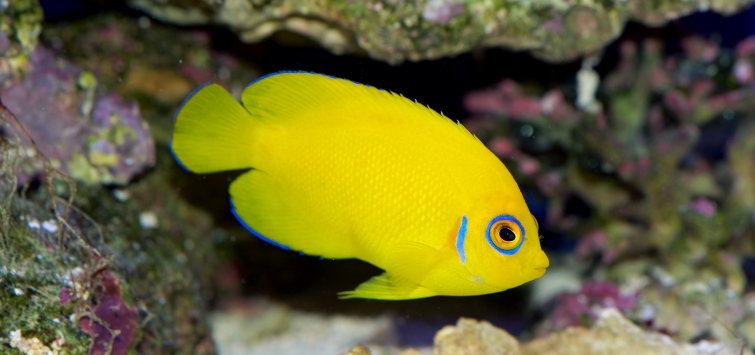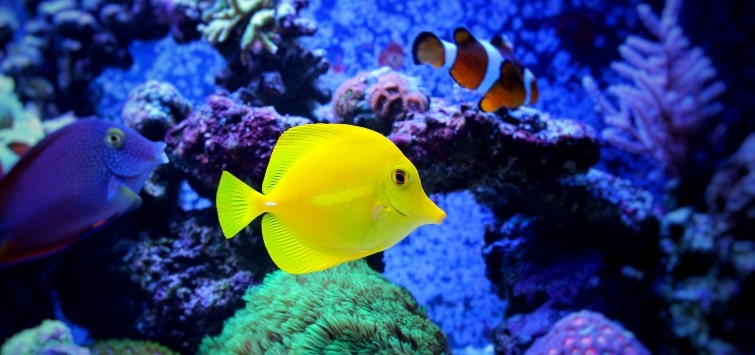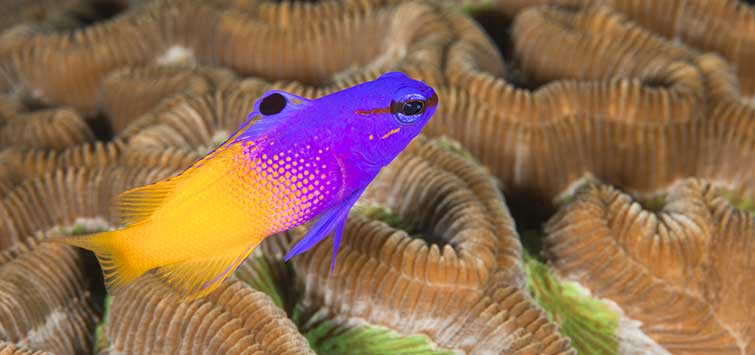Vivid Yellows and Gorgeous Golds
Author: Richard Aspinall
A diver, photographer, and aquarist continues his series on fishes belonging to different color groups with a look at some species found in yellow and gold hues.
Golden Beauties
There is something wonderful about yellow fishes, both in the wild and in the aquarium. Nothing beats seeing a shoal of vivid yellow pass you by, and nothing completes a fish collection like a bright yellow or golden specimen. I suspect our love of yellow and golden fishes is due to contrast; a reef scene is typically dominated by muted shades that are leaning towards the blues, and a yellow fish catches our eye like no other against this slightly muted palette of shades and even better against dark blue or black tank backgrounds.
When I’m diving with my camera, it tends to be the shoals of yellow fishes that I’ll spend time photographing, and when visiting an aquarium it will no doubt be the yellow fish, the tang or the butterfly, that will catch my (and your) eye first. To be honest, I don’t really know why. Perhaps it’s the contrast or perhaps it’s some hard-wired human attraction to the warmth of the sun or a cultural love of gold and a sense of value. I can make a few suggestions about why we love yellows, but we must remember that those colors are not really for us. Whatever the case, whatever the reason behind evolution’s blind tinkering, “a series of fortunate mistakes,” I know that there are few fish colors that attract the eye like yellow.
Coloration in Families
Yellow coloration is not distributed evenly among fish families; some families and genera tend towards sharing lifestyles and biology that make yellow evolutionarily useful, and yellows are well represented in the number of species thus colored. Think of a butterflyfish, for example, and the chances are you will think of a yellow fish, think of a tang and the likelihood is that your thoughts will turn to Zebrasoma flavescens.
Yellow coloration serves to make some species more noticeable to aid with shoaling and mass-spawning events, and for others it serves to indicate unpalatability. Just as wasps are yellow to warn predators, so are some fishes.
Yellow Clown Goby (Gobiodon okinawae)
Western Pacific, to 1½ inches (4 cm)
This diminutive but charming fish has a slightly different lifestyle from the many gobies that spend the bulk of their time close to the substrate. G. okinawae spends its time resting within the branches of corals, darting out to catch passing foodstuffs. For a fairly sessile species the yellow clown goby will entertain its owner by moving from coral to coral frequently, so it is likely to be seen on a regular basis.
Having such a visible presence indicates that this small, easily eaten fish has evolved skin mucus that is unpalatable to predators, which learn to associate the bright yellow with an unpleasant taste. Clearly such evolutionary traits do not serve to protect the fish that is spat out after being chewed up, but those genes are a little more likely to survive in the unfortunate fish’s siblings, and thus evolution progresses.
Captive Care
In captivity, G. okinawae is a great fish that because of its size and habits can be kept in nano tanks with ease, but it is also happy in much larger systems where it can offer more in the way of “close-up” interest. Indeed some of my favorite tanks over the years have supported a number of G. okinawae that can be seen dotted here and there.
These gobies are reef-safe, and the corals in which they rest up do not seem to be damaged. In small tanks, you can keep the fish singly or in pairs. Pairs may well breed if the conditions are suitable. Feed small pieces of meaty foods or frozen zooplankton like copepods.
G. okinawae is very susceptible to ectoparasites such as Cryptocaryon (saltwater ich), which can take a toll on this small species.
Foxface Rabbitfishes (Siganus vulpinus and Siganus unimaculatus)
Western Pacific, 8–9 inches (20–23 cm)
It’s no mistake that I list these two wonderful fishes after G. okinawae, as they too rely on chemical defenses to protect them, though in a categorically different fashion. These two are venomous! It’s worth noting here the distinction between venomous and poisonous; the former describes something that has the potential to sting, bite, or inject venom into potential prey or a predator for aggressive or defensive purposes. The latter describes something that if you eat it will make you ill to one degree or another. I have often heard people say that lionfishes are poisonous; this is not true, but they are venomous.
The Siganidae, the rabbitfishes, provide several excellent species for the larger aquarium. Several species are yellow, and although they tend to be grazers on algal growth the occasional fish can nip at corals, so they aren’t considered entirely reef safe.
I’ve chosen to include the two “‘foxface” species here, S. vulpinus and the slightly smaller S. unimaculatus (identified by one spot on the flank). These fishes are very attractive, with rich yellow coloration that tends toward the gold in healthy specimens. Their bold black-and-white head patterning contributes to their eye-catching nature.
Captive Care
While the two species may eat corals and other sessile invertebrates, they do tend to be quite peaceable and are less troublesome than tangs, for example. Like some of the tangs they are often found in dealers’ tanks looking a little skinny, often because the dealers have not fed them adequately. Although they are predominantly vegetarian, I have found they will take occasional meaty foods that help them “bulk up.”
Venom
Incidentally, the venom that these fishes possess is delivered through the dorsal spines. I did a quick search on a few web-based forums and found that stings have been recorded, but mainly when the fish was cornered, though one account detailed the case of a worker in a fish store who was stung by a dead specimen that had been placed in the trash.
Yellow Tang (Zebrasoma flavescens)
Central Pacific, around 8 inches (20 cm)
Since I’ve looked at the siganids, this presents the best opportunity to look at their relatives, the tangs, of which there is one very notable yellow species. We are of course talking here about that stalwart of the aquarium trade, the yellow tang.
Just about every marine aquarist has owned a yellow tang at some time or other. They are fairly hardy, easy to feed, cheap, and available in almost every store. They have also been at the center of the debate about the collection of species from the wild for the aquarium trade, with each side of the debate claiming that it best represents the interests of wild stocks. Whatever the reality, I think we should remember that even though these fish are relatively inexpensive they should be given the very best of care and should be protected from poor water quality and the stress and disease that invariably follow. In that manner we can take fewer fish from the wild.
Disease Resistance
Tangs can be prone to a range of disease issues, from lymphocystis, to ich, to head and lateral line erosion (HLLE). Help keep your yellow tang in the best of health by providing well-oxygenated, clean water and giving these very mobile fish the room they deserve—no less than 75 gallons (284 liters) for one yellow tang in my opinion.
Captive Care
Yellow tangs can be kept in shoals in larger systems, but they will need to be added at the same time. They can be aggressive to their relatives and closely related species in particular. Their diet should be one of marine algal matter and occasional meaty foods. The trend of late has been to avoid terrestrial vegetation such as lettuce in favor of seaweeds such as Porphyra (nori). This seems appropriate and will ensure a useful supply of iodine, vitamin C, and protein along with micro- nutrients.
Royal Gramma (Gramma loreto)
Tropical Western Atlantic, to 3 inches (7.6 cm)
Of all the marine aquarium fishes that are available to hobbyists, this species has to be one of the best. Entirely reef safe, far less aggressive than its relatives, and drop-dead gorgeous, the royal gramma is a stunner. Admittedly it isn’t entirely yellow, but the yellow portion of its body really stands out.
Royal grammas are best kept singly with adequate rockwork for them to shelter in as necessary.
Feeding
Grammas are known to “fade” a little, and it has been suggested that this can be alleviated through a well-planned and varied diet that can consist of vitamin-enriched live food as well as flake foods—they are not picky. I should add that they may eat ornamental shrimps, so don’t add sexy shrimp unless you want them to be part of their menu. They will leave cleaner shrimps alone, though.
As mentioned, this fish is not entirely yellow; it seems to have been dipped headfirst into purple paint.
Pictichromis paccagnellae
Aquarists may also want to look out for the similarly colored Pictichromis (formerly Pseudochromis) paccagnellae or P. dinar. These boldly colored fishes are considerably more territorial than G. loreto and are best kept by themselves or added to an established community with tankmates tough enough to stand up to their aggression. P. diadema, with its yellow flanks and purple dorsal surface, would be a good choice as long as you factor in its potential territoriality.
Copperband Butterflyfish (Chelmon rostratus)
East Indian and Western Pacific Oceans, to around 8 inches (20 cm)
This is a real beauty of a fish, though not one that can be recommended to any but the most expert and diligent aquarist. Sadly, it is often bought by inexperienced fish keepers who are often badly advised, only to have their fish die of starvation, disease, or both. The key seems to be initiating and maintaining feeding; some fish will take to aquarium fare such as chopped meaty foods, whereas others will not. If you choose to buy one of these fish, be prepared to feed it properly and with care for the many years that it is capable of living. It is not a beginner’s fish!
Many copperbands are bought in order to rid tanks of Aiptasia anemones, which not all will do; hobbyists may then find that zoanthids or other polyps are on the menu. The long, delicate mouth of this species is indicative of its in-the-wild feeding habits, as it has evolved to be able to reach between coral skeletons to pick out invertebrates, not to catch food items in the water column.
Captive Care
The copperbands that I have seen thrive tend to be ones kept in large tanks with excellent water conditions and with lots of swimming space and refuges in which the fish can feel safe. Although pairs set up territories in the wild, this fish is best kept singly.
Longnose Butterflyfish (Forcipiger spp.)
Indo-Pacific, around 8 inches (20 cm)
A chaetodontid that is more likely to adapt to captivity is one of the two species in the genus Forcipiger, with F. flavissimus being considered the easier to adapt to aquarium life and feeding.
I have to admit to having a blind spot with these fishes and often find it hard to tell F. flavissimus from F. longirostris without contrasting the two. Both are superficially similar, but the mouth of F. longirostris is longer and more tube-like, which suggests that it will be harder to feed. Both rely on taking small crustaceans from between crevices and coral branches, but of the two species F. flavissimus is reported to be far easier to accustom to taking finely chopped meaty foods and will thrive in reef tanks that are full of small crustacean life.
Like all other butterflyfishes, “long noses” require the very best water quality and a great deal of swimming space.
Other Yellow Butterflyfish Choices
There are several other yellow butterflyfish choices, with Klein’s butterflyfish (Chaetodon kleinii) and the pyramid butterflyfish (Hemitaurichthys polylepis) being two yellow choices that are relatively hardy. The recent interest in species from the Red Sea has introduced many aquarists to the masked butterflyfish (Chaetodon semilarvatus), which has a reputation for hardiness but is not, I believe, reef safe. I have to admit to not knowing a great deal about this species in captivity, but I understand it will take meaty foodstuffs.
Lemonpeel Angelfish (Centropyge flavissima)
Western Pacific, to around 6 inches (15 cm)
C. flavissima is just about my all-time favorite angel, gorgeously colored with that delicate edging of neon blue and inquisitive and full of character by nature. It’s a fabulous fish that, sadly, is one of the worst of the “coral nippers” in the Centropyge clan. If you want a yellow fish for a fish-only-with-live-rock (FOWLR) system, get one of these beauties; they are robust, feed on a variety of foodstuffs, and are the yellowest of yellows.
Hybridizing
Lemonpeels are also well known for hybridizing with other species, and on occasion crosses with the pearlscale angelfish (C. vroliki) and Eibl’s angelfish (C. eibli) arrive in the stores. According to Helmut Debelius, the Indian Ocean population of the lemonpeel lacks the blue eye ring of the Pacific population, with the Indian Ocean fish retaining the eye spot on the flanks until the subadult stage.
The similar golden dwarf angelfish (C. heraldi) represents a less robust choice but is equally yellow.
Feeding
C. flavissima will take most offered foods but will do best on a mixed diet that includes meaty foods and prepared foods that contain marine algae.
Coloration
It’s interesting to note that juvenile mimic tangs (Acanthurus pyroferus) can mimic the coloration of various Centropyge angels, including the stunning yellow of the lemonpeel angel, but they develop brown coloration as they reach adulthood.
Canarytop and Canary Wrasses (Halichoeres leucoxanthus and H. chrysus)
Eastern Indian and Western Pacific Oceans, to 5 inches (13 cm)
I’ve saved the best two for last. Really, I hear you say, but they’re just boring wrasses! Well, technically they are; they’re straightforward Halichoeres wrasses with nothing to make them stand out. Neither species is rare, and neither has stunning coloration or remarkable behaviour. But think again, these fishes have everything we want in a fish and should be treasured for being so wonderful.
They are brightly colored, hardy and robust, easy to feed, reef safe (may take small crustaceans), and aggressive only with congeners. In addition, they may eat noisome flatworms and are common in the wild and inexpensive in the stores. Halichoeres wrasses are active and always on the go as they hunt over the rockwork and substrate for prey that in the wild would consist of small worms and crustaceans. If they have one downside it would be that they can liberate a fair amount of substrate into the water column when they “dive” into the sand at night to sleep or when they feel threatened.
So it works out that my candidate for the best yellow fish, a fish that represents all that we should hold dear, a fish that will survive for years with ease and is undeniably attractive, is actually two different species—but to my mind those two species are almost indistinguishable in the degree of aquaristic virtue they represent, so let’s just call them co-champions.
Postscript: A Couple Rarer Choices
H. clarionensis
Probably the most famous member of the genus Holacanthus, and arguably the most expensive, is H. clarionensis, the clarion angel. (I’m not sure whether the Clipperton angel [H. limbaughi] would command a higher price.)
Clarions are rare and expensive and in my opinion are sought after perhaps more for their rarity than their intrinsic beauty. They are fantastic, but there are fishes that are perhaps more attractive in a straight comparison. The queen angelfish (H. ciliaris) is, I believe, a more attractive fish at all stages of its life cycle.
Hailing from a limited geographic range and with only limited opportunities for capture, wild-caught clarions are few and far between. I’ve only ever seen a handful, though I have been lucky enough to see a pair.
The dollar value of clarions has stimulated breeders, eager to increase their profits, to produce captive-bred specimens, and they’ve had some success.
Apolemichthys xanthopunctatus
We have a saying in the UK about people having deep pockets but short arms. If you’re one of those lucky people with long arms and well-filled deep pockets, you might consider another rare angel—the goldflake.
The goldflake angelfish (Apolemichthys xanthopunctatus) originates from a small number of islands in the Pacific. As both its common and specific taxonomic names suggest, it does look as if it is spotted with golden flakes (xantho = yellow and punctatus = spotted). Blue fin margins and a blue mouth help make the goldflake angel one of the most attractive of fishes.
Luckily for people willing and able to find the cash to buy one of these beauties, they are quite hardy. Folks like me with less available money to spend on the hobby might want to consider the similar three-spot angelfish (A. trimaculatus)
See the full article on TFH Digital http://www.tfhdigital.com/tfh/september_2014#pg69

.png?h=595&iar=0&w=2781&hash=5FD5E69473BCC22199FBFA2FB71B6033)



